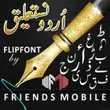Nastalq (Persian: نستعلیق, from نسخ Naskh and تعلیق Taʿlīq) is one of the main calligraphic hands used in writing the Persian script, and traditionally the predominant style in Persian calligraphy.[1] It was developed in Iran in the 14th and 15th centuries.[2] It is sometimes used to write Arabic-language text (where it is known as Taʿliq[citation needed] or Persian and is mainly used for titles and headings), but its use has always been more popular in the Persian, Turkic and Urdu sphere of influence. In Iran, Pakistan, India, Afghanistan, and other countries, Nastallaq is extensively used for poetry and as a form of art.
Nasta-l-q, a less elaborate version of the Pashto style, is used for writing Kashmiri, Punjabi and Urdu. It is used only for poetry in Persian. The nastalq was historically used for writing Ottoman Turkish, where it was called tâlik (3), a Persian style also called taploq; the latter was referred to as taploq-i qadim to distinguish it from the former.
Nastalq is the core script of post-Sassanid Persian writing, and its cultural influence extends beyond the area under its influence. Iranian languages (Western Persian, Azeri, Balochi, Kurdi, Luri, etc.), Afghan languages (Dari, Pashto, Uzbek, Turkmen, etc. ), Pakistani languages (Punjabi, Urdu, Kashmiri, Saraiki, etc. ), and the Turkic Uyghur languages of the Chinese province of Xinjiang, all depend on nastalq. This style was used by Ottoman calligraphers who developed the Diwani (divani) and Ruqah (rk'a) styles using it.
Nastalq is one of the most fluid styles of the Arabic alphabet. A short vertical stroke is paired with a long horizontal stroke, and no serifs are present. In Arabic and Persian, it is written using a trimmed reed with a tip measuring 5–10 mm (0.2–0.4 in), called qalam ("pen"), and carbon ink, named davat. A qalam's nib can be split in the middle to facilitate ink absorption.
Chalipa and Siah-Mashq are important forms of Nasta'lq panels. The Chalipa ("cross" in Persian) panel usually consists of four diagonal hemistiches (half-lines) of poetry depicting moral, ethical, or poetic concepts. However, Siah-Mashq ("black drill") panels communicate through composition and form rather than content. Using Siah-Mashq, repeating a few letters or words (sometimes even one) inks the entire panel. As a result, the content has less significance and is not easily accessible.
Final Thoughts
This App for Android devices is another amazing one. It's great that you have this ultimate apk with you, and on top of that, you have the premium version 2.0.01-1 of this apk. Have fun by following the above-mentioned instructions. And share this with your friends and family members.









